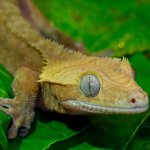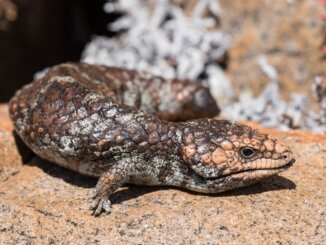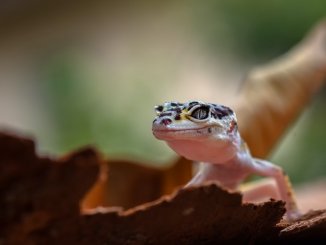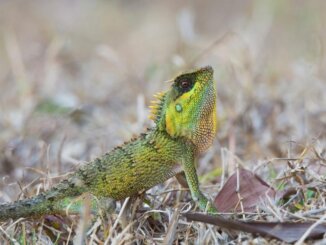The Crested Gecko is a colorful lizard famous for crests that run from head to tail. They have small spines above their eyes that look like eyelashes.
This species is known for licking their eyes, their expressive faces and can only be found on the islands of New Caledonia.
Crested Geckos are very popular with beginners for their ease of care, simple diet and easy tank set up.
Interested to learn more about this great beginner Gecko? Keep reading to learn how to care for them…
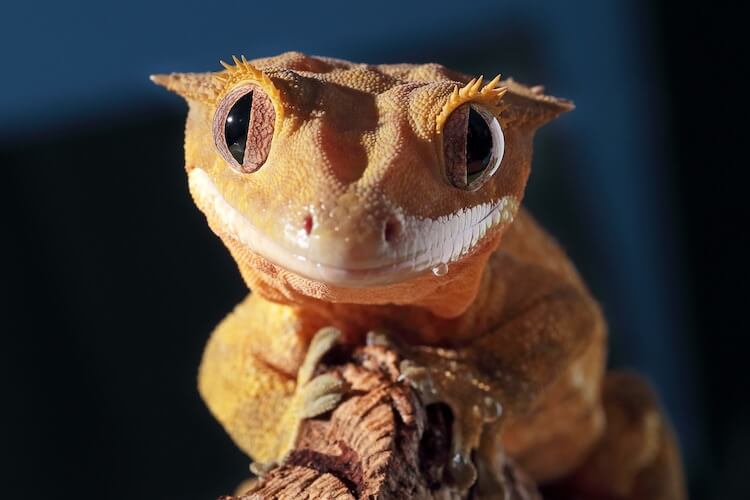
What Is A Crested Gecko?
Crested Geckos are nocturnal reptiles from the rainforests of New Caledonia – a group of islands near Australia.
They were first discovered in 1866 and were then thought to be extinct until their rediscovery in 1994.
The Crested Gecko spends their daytime hiding near the ground and in the evening they hunt and scavenge in the canopies of trees.
Scientifically this species of Gecko is known as the Rhacodactylus ciliatus, though previously named correlophus ciliatus, so you may see it named as either.
They come in a variety of colors and patterns and are particularly unique for their crests which run from head-to-tail. Their “eyelashes” form part of this crest and are unique in the reptile kingdom!
Are Crested Geckos Good For Beginners?
Yes. These exotic reptiles are known for being very easy to care for and their unique appearance. They are relatively healthy reptiles and provided they are handled properly are very friendly.
They can easily live in simple 20-gallon tanks filled with branches and leaves.
Crested geckos eat a variety of fruits a couple of times each week and the occasional small insect.
They also make great community reptiles because and will get along with other reptiles they are raised with.
What We Like About Crested Geckos
Pros
- They have a very unique appearance with their crests and “eyelashes”.
- No additional heating or lighting is required to replicate their natural habitat.
- They are very easy for beginners to care for.
Cons
- They frequently hide in captivity (as they would in the wild to avoid predators).
- It is very rare to see them during daylight hours as they are nocturnal.
Appearance
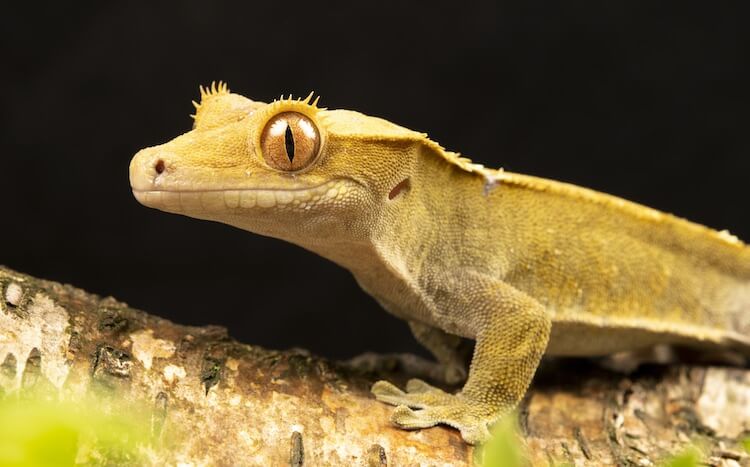
The most prominent feature of Crested Geckos is their eyelashes.
A Crested Gecko’s lashes make them easy to identify but they are also part of the crest that runs from each eye to their tail. They do not have eyelids, so these spiny projections protect their sensitive eyes from the brush and canopies they hide in. They also lick their eyes to keep them healthy.
Their sensitive eyes have slit-like pupils when it is bright and dilated pupils at night when they hunt.
This species has a large triangular head with holes on either side, four legs that end with four fingers. These fingers each have specialized toe pads with a network hair-like projection (called a seta) that allows them to climb on smooth surfaces!
They also have a prehensile tail that helps them grips things.
Crested Gecko Size
A fully grown adult will grow eight to ten inches and weigh 30g to 35g within their first 12 months.
Females become sexually mature at 12 months and males become fully mature at nine months.
Male and females are similar in size, weight, and appearance. However, males have hemipenes – paired reproductive organs that can be viewed externally by finding the bulges on either side of their tail.
A hatchling is born between ⅖ to 1″ in size.
Colors
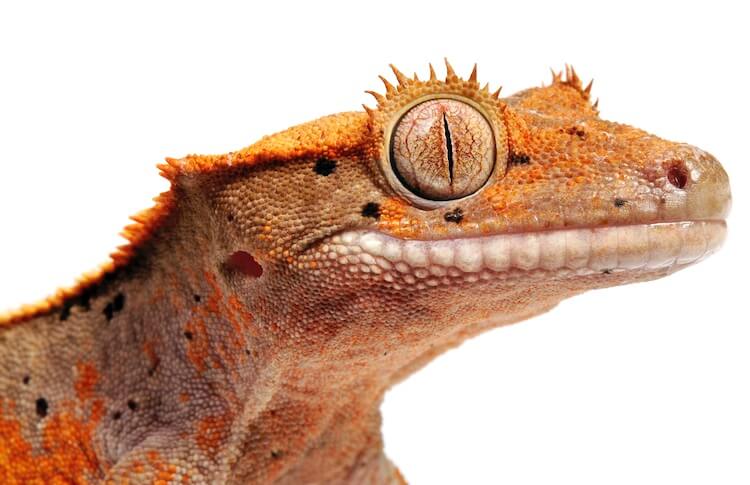
Normally a Crested Gecko’s back has large dark lateral stripes and can come in a range of colors:
- Light tan
- Peach
- Reddish-brown
There are three color morphs that can be found:
- Tiger morphs have patterned bellies as well as dark stripes on lighter skin.
- Patternless morphs are without pattern and solid in color.
- White-fringed morphs have white or yellow coloration on their crests
Crested Geckos have the ability to slightly change their color to camouflage themselves or to communicate with other reptiles.
Crested Gecko Care Sheet
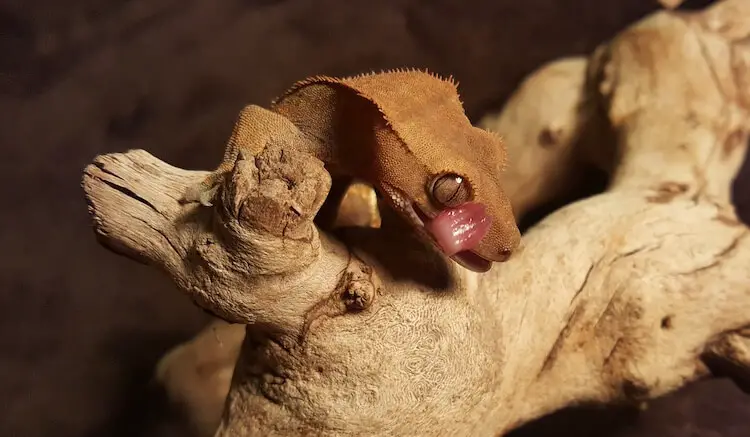
Crested Gecko Diet
A balanced diet is important for your Gecko. It is important you feed both insects and fruits. This will prevent an imbalance of nutrients and a lack of calcium that may lead to issues such as metabolic bone disease.
This species of Gecko is an omnivore and eats a variety of fruits and insects.
They will emerge from their hiding place a couple of times each week to feed.
There are companies that produce pre-balanced diets and feed but this is not necessary. Their diet is so straight forward you can easily give them a well-balanced diet without a commercial pellet.
What Do Crested Geckos Eat?
This reptile mostly lives on small insects and overripe fruits.
In the wild they will come out infrequently to eat and mostly eat fruits that are are a day or two old.
Their favorite prey insects include small roaches and crickets. Feed one insect a couple of times each week dusted with calcium and vitamin D3.
Each mealtime offer a couple of small pieces of banana, peach, passion fruit, or apricot. You can also give them mashed fruit.
Juveniles and hatchlings require the same diet just in smaller amounts. Hatchlings will not eat for the first few days of their lives because they used stored yolk remains for sustenance.
Crested Geckos do not like fresh or ripe fruits – uneaten food should be cleaned out once a week.
The best time to feed is late evening. Do not be surprised if you don’t see them eating during daylight hours.
They should have access to clean water at all times. A very shallow bowl is best.
Crested Gecko Lifespan and Health
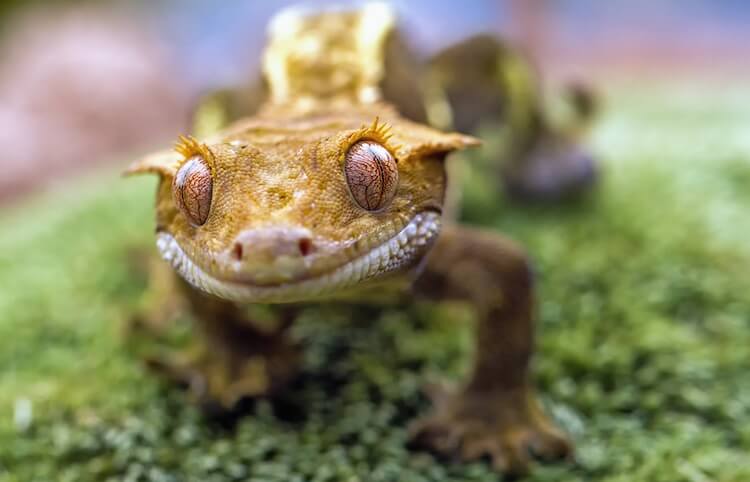
In captivity they will live up to 20 years, or even longer on some occasions, provided they are well cared for, are fed a healthy diet and receive routine husbandry.
Like other popular reptiles, this species is generally as healthy as their environment and diet:
- Overfeeding may lead to obesity
- A lack of calcium may lead to metabolic bone disease
These reptiles have endolymphatic sacs on the roofs of their mouths to store calcium.
Calcium deficiency or careless breeding can lead to abnormally shaped eggs (post-ovulatory dystocia) as a large calcium reserve is required to form eggs.
Their feces should be part brown (from food waste) as well as solidified or liquid urine. It is okay for the feces to be slightly runny. However, if it is runny or bloody for multiple days then seek medical advice.
Provided they are hydrated and healthy, they should have no problem shedding their skin and are often found to be eating it.
To keep this reptile healthy, humidity should be between 60 to 70%, and their tank should be misted daily with a spray bottle.
After misting, wait for between five minutes and wipe the glass walls down.
Signs They Are Healthy
- Sleeping and hiding during daylight hours.
- Regularly licking their eyeballs.
- Regularly coming out at night to eat.
Sickness Symptoms
- Sudden weight loss.
- Darker skin color than usual.
- Abnormal or bloody feces.
Crested Gecko Habitat
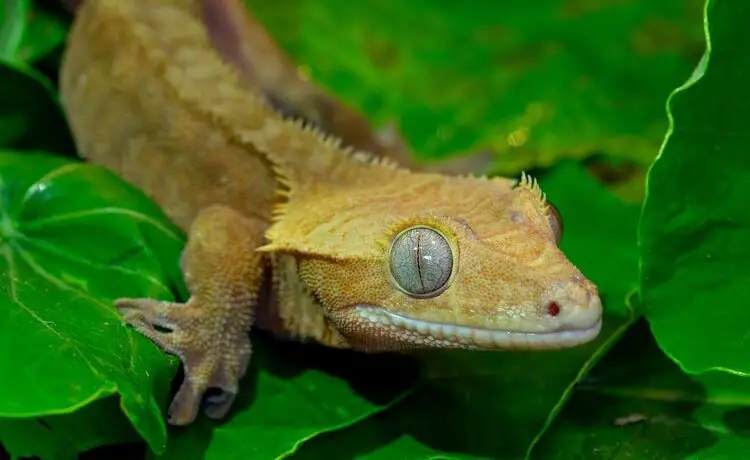
This Gecko is native to the rainforests of New Caledonia – specifically the Isle of Pines and Grand Terre.
These are two islands near Australia that have warm tropical rainforests with thick vegetation.
In the evening they rest in low canopies of trees that are as low as nine feet off the forest floor. In the daytime they are a couple of feet off the floor.
Crested Geckos Tank
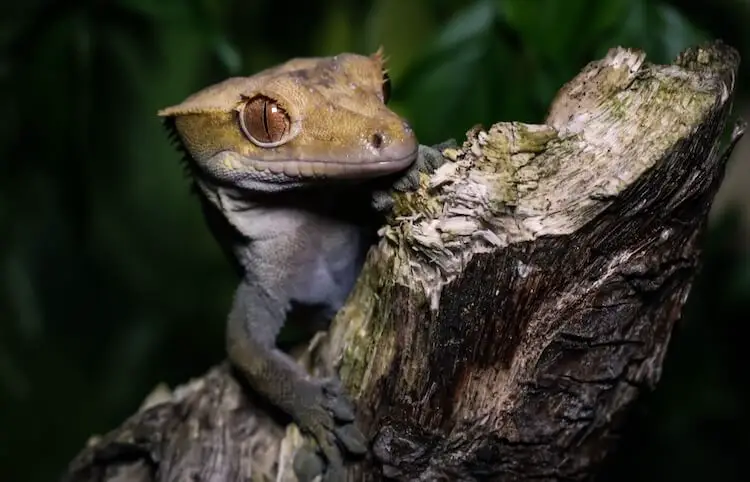
Glass tanks work best for Crested Geckos because they like to climb smooth surfaces. Tanks that are four to six feet high with a capacity of 20-gallons are ideal:
- Tank Type: glass tank.
- Tank Size: 20-gallon.
- Lighting: none.
- Substrate: soil.
Hatchlings and juveniles can be housed in smaller 10-gallon tanks, but they should be moved to larger tanks by the time they are one year of age.
Because Crested Geckos are nocturnal they naturally hide during the day. They should have plenty of things and places to hide in such as vegetation, plants, branches, logs, leaves, and egg cartons.
As long as your Gecko feels safe in their environment they will be happy.
Tank Setup
Because they are nocturnal no additional lighting or cage hood is required.
You should try not to interrupt their circadian rhythms. Lights near your gecko’s tank should be turned off when the sun is down. Try and mimic the natural pattern of the sun.
You can use a UV light during the day if their tank is not placed close to natural lighting, however, it is not necessary.
Unlike similar geckos their tank does not need to be much above room temperature and should be kept at about 75°F.
The humidity should be kept between 60 – 70% and can be maintained by misting daily with a spray bottle. After misting, wait for between five minutes and wipe the glass walls down.
A humidity gauge can help you ensure the correct environment.
Substrate
This species is not known for being picky with its substrate. You can either use soil or paper towels.
Soil best mimics their natural environment and will also support live plants in the tank. Cypress mulch or coconut fibers are excellent alternatives to soil.
Paper towels are more disposable and can be cleaned must faster during spot cleaning.
Make sure the substrate does not increase the humidity too much and is easy to clean.
Tank Cleaning
Excess food should be removed weekly. The rest of the tank should be spot cleaned when necessary.
Ideally, their tank should be deep cleaned every month with a full substrate change. Regular cleaning will help to keep your reptile healthy!
If bacterial growth does occur remove your reptile from their tank, change all the substrate, and deep clean the tank.
Typical Behavior
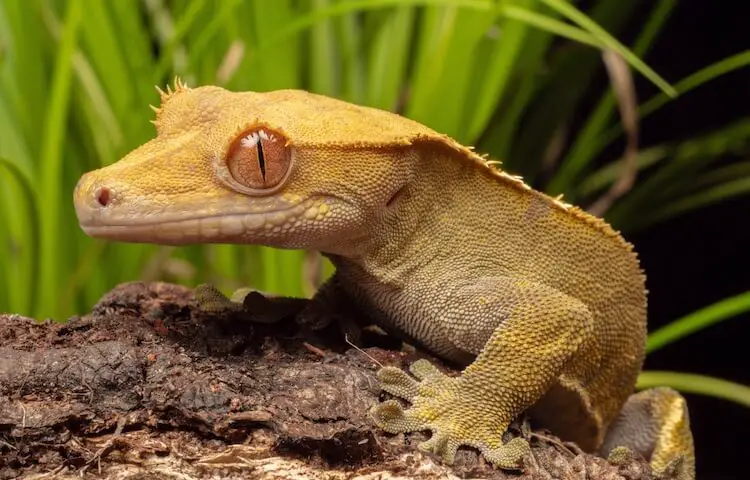
Crested Geckos hide in the lower brush during daytime to keep out of the way of sunlight and potential predators.
In the evening they spend their time in the canopies of trees climbing from branch to branch hunting for insects and scavenging for fruit. They are arboreal reptiles.
When they are hunting and feel threatened, they may stand up on their hind legs and hiss. In extreme signs of fear, they will lose their tail!
They are known to communicate with tank mates by emitting a high-pitched chirping sound – they also make this noise if they feel a predator is nearby.
Crested Geckos will display natural behaviors in captivity, including:
- Hiding in the tank during the daytime.
- Hunting for food in the evening.
Males are aggressive towards one another, especially if there are fewer females around. Females show signs of aggression if they do not want to copulate with an advancing male.
Do Crested Geckos Like To Be Held?
Yes. They are a relatively docile lizard and tolerate being handled. They are not terribly aggressive towards their handlers and are not known to bite.
In captivity, they do not hibernate.
They do go through a period of time (four months each year) where they do not breed during the cooler months.
Baby Crested Geckos
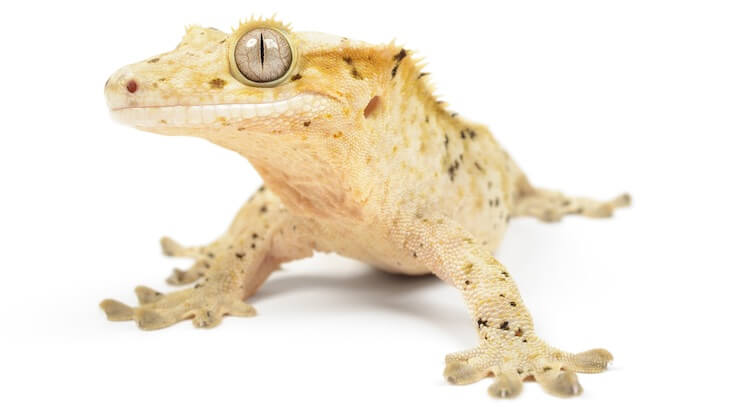
Baby Crested Geckos are independent from the moment they hatch. Neither the mother nor father takes part in raising hatchlings or juveniles.
After hatching they will not eat for the first few days as they used stored yolk remains as food.
Once they shed their skin for the first time they can eat an adult diet in smaller amounts. As they are immediately independent after birth they are able to self-regulate their food intake.
How Much Does A Crested Gecko Cost?
They are a very common species and there are many responsible breeders and they normally cost from $50 to $150.
It has been illegal to export a Crested Gecko from New Caledonia since their rediscovery in 1994.
When mating, a male will use jerky movements as he approaches a female. If she accepts, the male will then climb on her back and gently bite her neck.
Once copulation is over a female may lay two eggs 30 – 40 days later. Female geckos retain sperm, so they may become fertilized again without mating.
The eggs hatch 60 to 70 days after being lain. Interestingly, tank temperature will impact the sex of a hatchling. Warmer temperatures increase the probability that more males will hatch and the opposite is true for cooler temperatures.
Higher incubation temperatures will also lead to faster egg development.
| Crested Gecko Facts | |
|---|---|
| Common Names | New Caledonian Crested Gecko |
| Scientific Name | Rhacodactylus ciliatus |
| Adult Size | 8 – 10 inches |
| Lifespan | 15 – 20 years |
| Diet | Ripe or overripe fruit and crickets |
| Tank Size | 20-gallon tank |
| Humidity & Temperature | ~75°F and humidity should be kept between 60 – 70% |
| Popular Alternatives | Leachie Gecko, Gargoyle Gecko, Mossy Prehensile-tailed Gecko |
Care Sheet Summary
There are many species of Geckos from New Caledonia – most of which are from the Rhacodactylus family.
Crested Geckos are the most popular and friendly species from New Caledonia. The Leachie Gecko is very similar but is less tolerant of handling.
Crested Geckos are more outgoing than other geckos and are easy to care for. This makes them perfect for a first-time owner.
This colorful reptile can make a bright addition to any owner’s home. Their unique appearance and expressive faces are sure to bring some fun too.
Have you kept this reptile before? Tell us below!



